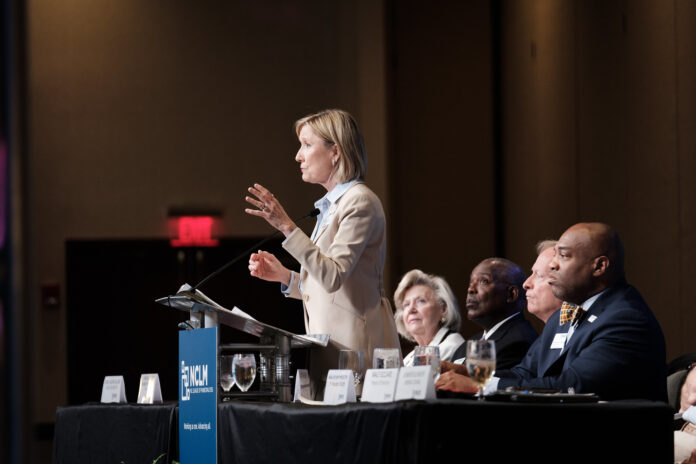Seven years into NCLM’s Strategic Plan, a review of the many successes and strides towards accomplishing Vision 2030’s six main goals.
All across the membership of the NC League of Municipalities, we see incredible successes. When viewed through the lens of our strategic plan, Vision 2030, those achievements take on added significance.
Around 2014, the League kicked off its strategic planning efforts to set goals and organize resources towards a long-term vision for both the organization and the municipalities themselves. The result was Vision 2030, published in 2016.
This year marks the halfway point of our efforts towards reaching those goals. The plan, organized through strategic planning pillars, offered six “Operating Principles,” which stand as strategic targets for the organization. Below, the Operating Principles are detailed, as is NCLM’s progress towards each.
Goal 1: Municipal governments exercise greater control over their revenues, structures, and functions.
The work of NCLM’s Government Affairs staff embodies this target, and the many legislative victories that team has achieved mark significant progress towards that goal. These include wins in the areas of land use and zoning, short-term rentals, sales tax redistributions, and billboards, just to name a few.
Of course, those victories aren’t achieved through our internal team alone. Equal, if not more important, is the tremendous work of our cities and towns. Through grassroots advocacy, the League’s interests are strongly supported at the General Assembly.
Goal 2: Municipalities demonstrate the value they add to the community’s quality of life.
NCLM’s Communications staff works tirelessly to share the incredible stories that happen across our state, and publish them in a variety of locations, including this magazine. These stories include case studies, best practices, and articles. More regularly, the team pushes information through its weekly bulletins and newsletters.
The American Rescue Plan has provided a clear case of the power of storytelling, both for our cities and for our organization. The League, working closely with city leaders, has published dozens of case studies illustrating the impact that our towns are having through their American Rescue Plan funds, and these case studies have gone on to be published in statewide news outlets.
Additionally, cities and towns have grown incredibly adept at telling their own tales. A quick walk around CityVision 2023 would reveal local leaders hosting a variety of panels and sessions, where their own stories of success provide tools and a roadmap to fellow municipalities.
Goal 3: Technology is widely used for service delivery, citizen engagement, and economic development.
Perhaps no goal has a clearer example than this one: the COVID-19 pandemic. In the blink of an eye, cities had to leverage technologies to quickly adapt their operations online and remote. Crucial offerings had to become digital, and technology became a necessity. They haven’t looked back. In the years since, our towns have developed faster and more efficient ways of reaching their citizens and providing services.
Through those trying times, and in the years that followed, we saw our towns commit to the use of technology through “smart” investments, such as smart utility meters, updated vehicles, and cybersecurity programs.
NCLM as an organization is also leveraging technology through its new Municipal Accounting Software program (see ARP Service Line article page TK), which will bolster and support the administrative capacity of small towns across North Carolina.
Goal 4: Municipalities widely practice productive partnerships with counties, other governments, and the private sector.
and
Goal 5: Urban and rural municipalities routinely work together for economic successes.
These two goals go hand-in-hand, and they are seen clearly through the pressing investment need of our time: water and wastewater infrastructure. Due in large part to the changing economic landscape of North Carolina over the past several decades, nearly every region of this state faces the problem of aging infrastructure. Our towns have responded through flexibility, leadership and, most importantly, partnerships.
Regionalization has proven incredibly successful in our cities and towns. By partnering (Goal 4) and working together to pursue economic successes (Goal 5), cities have found an attainable solution to a large problem. Bethel and Greenville provide a great case study. By regionalizing their water systems, those municipalities have developed both a sustainable and cost-efficient arrangement to addressing the water needs of their communities.
For examples of partnerships with counties and the private sector, we can look to the incredible downtown investments happening across North Carolina. The City of Kannapolis provides a strong example. By working with private investors and Cabarrus County, the city was able to undergo a massive and ambitious downtown renovation. Take a visit to Kannapolis sometime soon, and the results speak for themselves.
Goal 6: Municipalities are able to quickly adapt to cultural and demographic changes in their communities.
Small towns have shown themselves to be nimble and flexible over the past several years, and large towns have expertly navigated the challenge of growth.
Notable towards this goal are our cities’ and the League’s strides in the area of racial equity. NCLM released at CityVision in 2021 its report on “City Leadership and Racial Equity,” which examined and offered policy recommendations on the areas of housing, policing, infrastructure location and leadership development. Shortly after, we launched DIRECT—Diversity, Inclusion and Racial Equity for Cities and Towns—programming that helped strengthen communities by identifying and addressing racial disparities at the local level.
Seven years in, we’re well over halfway there. Now, just seven more to go to finish these goals off strong. There are certainly many more successes ahead.














